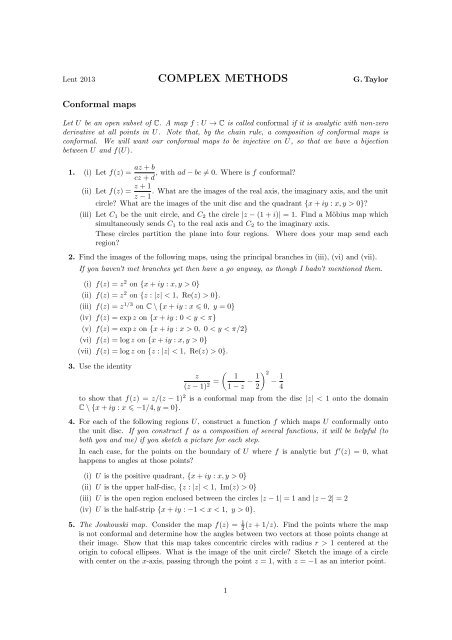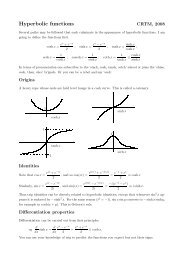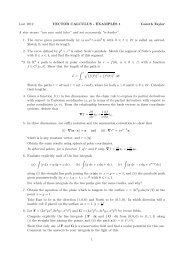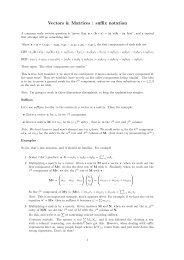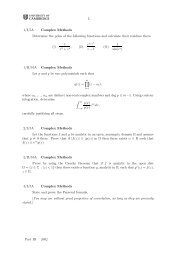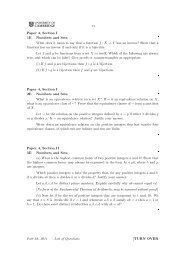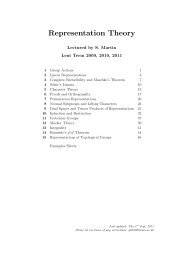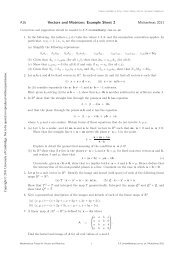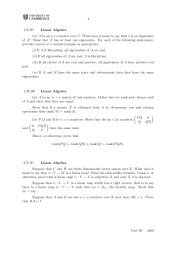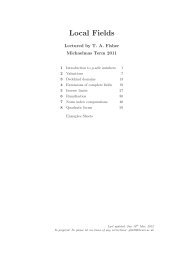examples sheets - Tartarus
examples sheets - Tartarus
examples sheets - Tartarus
Create successful ePaper yourself
Turn your PDF publications into a flip-book with our unique Google optimized e-Paper software.
Lent 2013 COMPLEX METHODS G.Taylor<br />
Conformal maps<br />
Let U be an open subset of C. A map f : U → C is called conformal if it is analytic with non-zero<br />
derivative at all points in U. Note that, by the chain rule, a composition of conformal maps is<br />
conformal. We will want our conformal maps to be injective on U, so that we have a bijection<br />
between U and f(U).<br />
az +b<br />
1. (i) Let f(z) = , with ad−bc ≠ 0. Where is f conformal?<br />
cz +d<br />
(ii) Let f(z) = z +1 . What are the images of the real axis, the imaginary axis, and the unit<br />
z −1<br />
circle? What are the images of the unit disc and the quadrant {x+iy : x,y > 0}?<br />
(iii) Let C 1 be the unit circle, and C 2 the circle |z −(1+i)| = 1. Find a Möbius map which<br />
simultaneously sends C 1 to the real axis and C 2 to the imaginary axis.<br />
These circles partition the plane into four regions. Where does your map send each<br />
region?<br />
2. Find the images of the following maps, using the principal branches in (iii), (vi) and (vii).<br />
If you haven’t met branches yet then have a go anyway, as though I hadn’t mentioned them.<br />
(i) f(z) = z 2 on {x+iy : x,y > 0}<br />
(ii) f(z) = z 2 on {z : |z| < 1, Re(z) > 0}.<br />
(iii) f(z) = z 1/3 on C\{x+iy : x 0, y = 0}<br />
(iv) f(z) = expz on {x+iy : 0 < y < π}<br />
(v) f(z) = expz on {x+iy : x > 0, 0 < y < π/2}<br />
(vi) f(z) = logz on {x+iy : x,y > 0}<br />
(vii) f(z) = logz on {z : |z| < 1, Re(z) > 0}.<br />
3. Use the identity<br />
z<br />
(z −1) 2 = ( 1<br />
1−z − 1 2) 2<br />
− 1 4<br />
to show that f(z) = z/(z − 1) 2 is a conformal map from the disc |z| < 1 onto the domain<br />
C\{x+iy : x −1/4,y = 0}.<br />
4. For each of the following regions U, construct a function f which maps U conformally onto<br />
the unit disc. If you construct f as a composition of several functions, it will be helpful (to<br />
both you and me) if you sketch a picture for each step.<br />
In each case, for the points on the boundary of U where f is analytic but f ′ (z) = 0, what<br />
happens to angles at those points?<br />
(i) U is the positive quadrant, {x+iy : x,y > 0}<br />
(ii) U is the upper half-disc, {z : |z| < 1, Im(z) > 0}<br />
(iii) U is the open region enclosed between the circles |z −1| = 1 and |z −2| = 2<br />
(iv) U is the half-strip {x+iy : −1 < x < 1, y > 0}.<br />
5. The Joukowski map. Consider the map f(z) = 1 2<br />
(z + 1/z). Find the points where the map<br />
is not conformal and determine how the angles between two vectors at those points change at<br />
their image. Show that this map takes concentric circles with radius r > 1 centered at the<br />
origin to cofocal ellipses. What is the image of the unit circle? Sketch the image of a circle<br />
with center on the x-axis, passing through the point z = 1, with z = −1 as an interior point.<br />
1
Cauchy-Riemann equations ; harmonic functions<br />
6. (i) Let u(x,y) and v(x,y) satisfy the Cauchy-Riemann equations, and define<br />
( z + ¯z<br />
g(z,¯z) = u<br />
2 , z − ¯z ) ( z + ¯z<br />
+iv<br />
2i 2 , z − ¯z )<br />
.<br />
2i<br />
Use the chain rule to show that ∂g/∂¯z = 0. Thus any analytic function may be written<br />
as a function of z only.<br />
(ii) Where, if anywhere, in the complex plane are the following functions differentiable, and<br />
where are they analytic?<br />
Imz ; |z| 2 ; sechz .<br />
(iii) Let f(z) = z 5 /|z| 4 (for z ≠ 0) and f(0) = 0. Show that at z = 0, the real and imaginary<br />
parts of f satisfy the Cauchy-Riemann equations, but that f is not differentiable there.<br />
When calculating, e.g., u x (0,0), set y = 0 before differentiating with respect to x.<br />
7. Let f(z) be analytic on an open set D. Show that if |f(z)| is constant on D, then so is f(z).<br />
8. Find complex analytic functions whose real parts are the following:<br />
(i) x (ii) xy (iii) sinxcoshy<br />
(iv) log(x 2 +y 2 )<br />
(v)<br />
y<br />
(x+1) 2 +y 2<br />
You should give functions of z, rather than of x and y. See 6(i).<br />
(vi) tan −1 ( 2xy<br />
x 2 −y 2 ) .<br />
Deducethattheabovefunctionsareharmonicandgivethedomainonwhichtheyareharmonic.<br />
9. By considering w(z) = i+z ( )<br />
i−z , show that 2x<br />
tan−1 x 2 +y 2 is harmonic. On what domain?<br />
−1<br />
10. Verify that the function φ(x,y) = e x (xcosy−ysiny) is harmonic. Find its harmonic conjugate<br />
and determine the family of curves orthogonal to φ(x,y) = α, for an arbitrary constant α. Find<br />
the analytic function f(z) such that Ref = φ. Can the expression f(z) = φ(z,0) be used to<br />
determine f(z) in general?<br />
11. The isothermal lines of a steady state temperature field are the family of curves x 2 +y 2 = α,<br />
where α > 0. Find the general expression for the temperature, its harmonic conjugate and the<br />
equation for the family of flux lines. Sketch the isothermal and heat flow lines.<br />
12. Show that<br />
g(z) = expz maps {x+iy : 0 < y < π} onto {x+iy : y > 0} ,<br />
and that<br />
h(z) = sinz maps {x+iy : −π/2 < x < π/2, y > 0} onto {x+iy : y > 0} .<br />
Find a conformal map of {x+iy : −π/2 < x < π/2, y > 0} onto {x+iy : 0 < y < π}.<br />
Find a function v which is harmonic on the strip {−π/2 < x < π/2, y > 0} with limiting<br />
values on the boundaries given by: v = 0 on parts of the boundary in the left half-plane, and<br />
v = 1 on parts of the boundary in the right half-plane. Is there only one such function?<br />
If you can, give v as a function of x and y, rather than of z.<br />
2
Branches ; series ; singularities<br />
13. Show how the principal branch of logz can be used to define a branch of z i which is singlevalued<br />
on the set D = C\{x+iy : x 0,y = 0}. Evaluate i i for this branch.<br />
Show, using polar coordinates, that the branch of z i defined above maps D onto an annulus<br />
which is covered infinitely often.<br />
14. How many branch points does f(z) = [z(z +1)] 1/3 have? Draw some possible branch cuts in<br />
the complex plane.<br />
If that went okay, repeat with f(z) = [z(z+1)(z+2)] 1/3 and f(z) = [z(z+1)(z+2)(z+3)] 1/2 .<br />
15. Let f(z) = zlog(1+z) with arg(1+z) ∈ [−π,π), and g(z) = zlogz with argz ∈ [−π,π).<br />
Explain why h(z) = f(z)−g(z) is analytic outside the unit disc, and find the Laurent series<br />
for h(z) about the origin in this region. Hence evaluate<br />
∮<br />
h(z)dz .<br />
|z|=2<br />
16. Find the first two non-vanishing coefficients in the Taylor expansion about the origin of the<br />
following functions, assuming principal branches for (i), (ii) and (iii). Where appropriate, you<br />
may make use of standard series expansions for log(1+z), etc.<br />
(i) z/log(1+z) ; (ii) √ cosz −1 ; (iii) log(1+e z ) ; (iv) e ez .<br />
State the range of values of z for which each series converges.<br />
In (i), (ii) and (iii), how would your series differ if you assumed branches different from the<br />
principal branch?<br />
17. Use partial fractions to find the Laurent expansions of 1/((z −a)(z −b)) about z = 0, where<br />
|b| > |a| > 0, in each of the regions |z| < |a|, |a| < |z| < |b| and |z| > |b|.<br />
18. Find and classify the singularities in the complex plane of the following functions:<br />
(i)<br />
(iv)<br />
1<br />
z 3 (z −1) 2 (ii) tanz (iii) zcothz<br />
e z −e<br />
(1−z) 3 (v) exp(tanz) (vi) tan(z −1 ) .<br />
How does tanz behave as |z| → ∞ with Imz = 0?<br />
19. Find the first three terms of the Laurent expansion of f(z) =<br />
By considering the function<br />
1<br />
1−cosz<br />
f(z) − 2 z 2 − 2<br />
(z +2π) 2 − 2<br />
(z −2π) 2 ,<br />
valid for |z| < 2π.<br />
find the three non-zero central terms of the Laurent expansion of f(z) valid for 2π < |z| < 4π.<br />
3
Integration<br />
∮<br />
20. Evaluate<br />
C<br />
∮<br />
¯zdz and<br />
C<br />
z 1/2 dz (use the principal branch of z 1/2 ) in the two cases:<br />
(i) C is the circle |z| = 1, and (ii) C is the circle |z −1| = 1.<br />
21. Evaluate, using Cauchy’s theorem or the residue theorem:<br />
∮<br />
dz<br />
(i)<br />
C 1+z 2 where C is the ellipse x 2 +4y 2 = 1;<br />
∮<br />
dz<br />
(ii)<br />
C 1+z 2 where C is the circle x 2 +y 2 = 2;<br />
∮<br />
e z coszdz<br />
(iii)<br />
(1+z 2 )sinz where C is the circle |z −(2+i)| = √ 2.<br />
C<br />
∮<br />
22. Evaluate<br />
C<br />
23. (i) Evaluate<br />
z 3 e 1/z dz<br />
1+z<br />
∫ ∞<br />
−∞<br />
, where C is the circle |z| = 2.<br />
dx<br />
by closing the contour in the upper half-plane.<br />
1+x2 How does the calculation differ if you close in the lower half-plane?<br />
∫ R<br />
xdx<br />
(ii) Evaluate lim<br />
R→∞ −R 1+x+x2. Why is the limit necessary?<br />
(iii) Evaluate<br />
∫ ∞<br />
−∞<br />
e ikx dx<br />
for k > 0 and for k < 0.<br />
1+x2 24. By integrating around a key-hole contour, show that<br />
∫ ∞<br />
0<br />
x a−1 dx<br />
1+x<br />
=<br />
π<br />
sin(πa)<br />
(0 < a < 1).<br />
Explain why the given restriction on the value of a is necessary.<br />
25. By integrating around a contour involving the real axis and the line z = rexp(2πi/n), evaluate<br />
∫ ∞<br />
0<br />
dx<br />
1+x n (n 2).<br />
Check (by change of variable) that your answer agrees with that of the previous question.<br />
∮<br />
26. By evaluating<br />
27. Establish the following:<br />
(i)<br />
∫ ∞<br />
0<br />
C<br />
z −1 dz, where C is the ellipse x2<br />
a 2 + y2<br />
= 1, show that<br />
b2 ∫ 2π<br />
cosxdx<br />
(1+x 2 ) 3 = 7π<br />
16e ;<br />
0<br />
dθ<br />
a 2 cos 2 θ +b 2 sin 2 θ = 2π<br />
ab<br />
(ii)<br />
∫ ∞<br />
0<br />
(b > a > 0) .<br />
sin 2 xdx<br />
x 2 = π 2 ; (iii) ∫ ∞<br />
0<br />
logxdx<br />
1+x 2 = 0 .<br />
For (iii), you could integrate (logz)2<br />
1+z 2 around a keyhole contour, or integrate logz<br />
1+z 2 along the real<br />
axis. (You could do both!) What goes wrong if you integrate logz<br />
1+z 2 around a keyhole?<br />
4
28. Using a rectangular contour, show that for a real,<br />
Find<br />
∫ ∞<br />
0<br />
x<br />
sinhx dx.<br />
∫ ∞<br />
0<br />
sinax<br />
sinhx dx = π πa<br />
tanh<br />
2 2 .<br />
29. Let P(z) be a non-constant polynomial. Consider the contour integral<br />
∮<br />
P ′ (z)<br />
I =<br />
P(z) dz .<br />
C<br />
Show that, if C is a contour that encloses no zeros of P, then I = 0. Evaluate lim R→∞ I,<br />
where C is the circle |z| = R, and deduce that P has at least one zero in the complex plane.<br />
30. By considering the integral of f(z) = cotz<br />
z 2 +π 2 around a suitable large contour, prove that,<br />
a2 if ia is not an integer,<br />
∞∑ 1<br />
n 2 +a 2 = π a coth(πa) .<br />
n=−∞<br />
By considering a similar integral, prove also that, if a is not an integer,<br />
∞∑ 1<br />
(n+a) 2 = π 2<br />
sin 2 (πa) .<br />
n=−∞<br />
Justify the limiting operation needed as a → 0 in order to deduce from each of these the value<br />
of ∑ ∞<br />
n=1 1/n2 .<br />
*31. Evaluate the following contour integrals:<br />
(i)<br />
∫ ∞<br />
0<br />
log(x+1)<br />
x a+1 dx (0 < a < 1) ; (ii)<br />
∫ 1<br />
−1<br />
√ ∫ 1−x<br />
2 2π<br />
1+x 2 dx ; (iii) log(5+4cosθ)dθ .<br />
0<br />
Fourier Transforms<br />
In all cases, the Fourier transform is denoted by a tilde and defined by ˜f(k) =<br />
32. Let<br />
f(x) =<br />
{ 1 for |x| < a<br />
0 for |x| > a<br />
Show directly that ˜f(k) =<br />
2sinak<br />
k<br />
and g(x) =<br />
and ˜g(k) = 2(1−cosak)<br />
k 2 .<br />
∫ ∞<br />
−∞<br />
{ a−|x| for |x| < a<br />
0 for |x| > a<br />
f(x)e −ikx dx.<br />
Find the convolution of f(x) with itself, and hence verify the formula for ˜g(k) using the<br />
convolution theorem.<br />
Verify by contour integration that the inversion formula holds for f(x).<br />
33. Using the Fourier inversion formula, show that, for a > 0,<br />
(i) e −a|t| = a π<br />
∫ ∞<br />
−∞<br />
e iωt<br />
ω 2 +a 2 dω, (ii) H(t)e−at sinbt = 1<br />
2π<br />
∫ ∞<br />
−∞<br />
be iωt<br />
(iω +a) 2 +b 2 dω,<br />
where H(t) is the Heaviside step function. What goes wrong with the integrals if a = 0? What<br />
are the values of the integrals when a < 0?<br />
.<br />
5
34. The displacement x(t) of a damped harmonic oscillator obeys the equation<br />
and ˜x(ω) and ˜f(ω) exist. Show that<br />
x(t) =<br />
∫ ∞<br />
−∞<br />
ẍ+2γẋ+q 2 x = f(t) (γ > 0)<br />
G(t−t ′ )f(t ′ )dt ′ , where G(t) = 1<br />
2π<br />
Verify formally, by differentiation under the integral sign, that<br />
∫ ∞<br />
−∞<br />
d 2<br />
dt 2G(t)+2γ d dt G(t)+q2 G(t) = δ(t) .<br />
e iωt<br />
q 2 +2iγω −ω 2 dω .<br />
Assume that the system is underdamped, that is that 0 < γ < q, and let p = √ q 2 −γ 2 .<br />
Deduce (see the previous question) that<br />
G(t) = 1 p e−γt sinptH(t) .<br />
35. Show that the convolution, h(x), of the function f(x) = e −|x| with itself is given by<br />
{ (1−x)e<br />
x<br />
for x < 0<br />
h(x) =<br />
(1+x)e −x for x > 0 .<br />
Use the convolution theorem to show that<br />
h(x) = 2 π<br />
Verify this result by contour integration.<br />
∫ ∞<br />
−∞<br />
e ikx<br />
(1+k 2 ) 2 dk .<br />
Laplace Transforms<br />
In all cases, the Laplace transform is denoted by L{f(t)} ≡ F(s) =<br />
∫ ∞<br />
0<br />
f(t)e −st dt.<br />
36. Use standard properties of the Laplace transform to find the Laplace transform of the following<br />
functions: (i) t 3 e −3t , (ii) 2e 3t sin4t, (iii) e −4t cosh2t.<br />
37. Use partial fractions and standard properties of the Laplace transform to find the inverse<br />
s+3<br />
Laplace transform of<br />
(s−2)(s 2 . Verify this result using a contour integral.<br />
+1)<br />
38. Find the Laplace transforms of f(t) = t −1/2 and g(t) = t 1/2 . Note that ∫ ∞<br />
0<br />
e −x2 dx = 1 2√ π.<br />
Verify (by integrating around a keyhole-ish contour) that the inversion formula holds for f(t).<br />
39. The Gamma function is defined for n > 0 by Γ(n) =<br />
∫ ∞<br />
0<br />
x n−1 e −x dx.<br />
Show that Γ(n+1) = nΓ(n), and hence that Γ(n+1) = n! if n is a positive integer. Using the<br />
previous question, write down the value of Γ( 1 2 ).<br />
The Beta function is defined for m,n > 0 by B(m,n) =<br />
Use the convolution theorem for Laplace transforms to establish that<br />
∫ 1<br />
B(m,n) = Γ(m)Γ(n)<br />
Γ(m+n) .<br />
0<br />
x m−1 (1−x) n−1 dx.<br />
6
40. Use Laplace transforms to solve the differential equation:<br />
y ′′′ −3y ′′ +3y ′ −y = t 2 e t ,<br />
with initial conditions y(0) = 1, y ′ (0) = 0, y ′′ (0) = −2.<br />
41. A linear system is described by the differential equation<br />
with initial conditions y ′ (0) = y(0) = 0.<br />
y ′′ −3y ′ +2y = u(t) ,<br />
Use Laplace transforms to determine the response of the system to the signal u(t) = t. Determine<br />
also the impulse response, i.e. the response y(t) to a signal u(t) = δ(t).<br />
42. By taking Laplace transforms, solve<br />
Verify your solution.<br />
f(t)+4<br />
∫ t<br />
0<br />
(t−τ)f(τ)dτ = t .<br />
43. By taking Laplace transforms, solve<br />
x ′ = 10y −5x<br />
y ′ = y −x<br />
with x(0) = 3, y(0) = 1.<br />
44. The Initial/Final Value Theorems.<br />
By considering the Laplace transform of f ′ (t), prove that<br />
limf(t) = lim sF(s)<br />
t→0 s→∞<br />
and, assuming that lim<br />
t→∞<br />
f(t) exists, prove that<br />
lim f(t) = lim sF(s).<br />
t→∞ s→0<br />
45. The zeroth order Bessel function J 0 (t) is defined by its series expansion to be<br />
J 0 (t) = 1− t2<br />
2 2 + t4<br />
2 2 4 2 − t6<br />
2 2 4 2 6 2 +···<br />
Find its Laplace transform, given that it obeys the differential equation<br />
tJ ′′<br />
0 +J ′ 0 +tJ 0 = 0 .<br />
Verify this by transforming the series expansion.<br />
Show that<br />
∫ ∞<br />
0<br />
J 0 (t)dt = 1. Find the convolution of J 0 with itself.<br />
Please send any corrections or comments to me at glt1000@cam.ac.uk<br />
7


